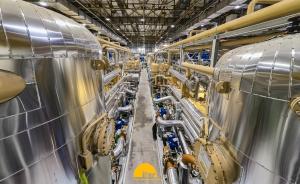The cryoplant
Cryogenics play a central role in the ITER tokamak: the machine's superconducting magnets (10,000 tonnes in total), the vacuum pumps, thermal shields and some elements of the diagnostic systems must be cooled to extremely low temperatures.
To perform this strategic task, ITER will operate one of the largest cryogenic installations in the world, a 5,400 m² facility packed with approximately 5,500 tonnes of equipment and many kilometres of piping that will manage, produce and distribute the required cooling fluids.
Construction of the ITER cryoplant began in the summer of 2016 and the building was ready for equipment about one year later. Three parties have shared responsibility for the procurement of the ITER cryoplant—the ITER Organization, responsible for the liquid helium plant; Europe, in charge of the liquid nitrogen plant and auxiliary systems; and India, whose contractors have procured the cryolines, the warm lines and cryodistribution components.
The installation entered its pre-commissioning phase in the fall of 2022. Subsystems are progressively entering dynamic testing in anticipation of starting up the core units of the cryoplant—two nitrogen and three helium refrigerators—in the second half of 2023. A closed loop will simulate the different clients inside the Tokamak, "much like a prototype engine is tested on a bench before being installed in the actual vehicle," explains David Grillot, the head of the ITER Cryogenic System Section.
By moving the computer mouse up, down, right or left and rolling the scroll wheel backward or forward within the frame of this "360° image of the week," the viewer can take in the extraordinary complexity of the cryoplant as well as the strange beauty of its shiny piping, tanks and exotic machinery.
Improved and refined by ITER contractor Emmanuel Riche, the 360° degree photography/VR technique provides an even more striking experience when viewed with a virtual reality headset. (If you have one, click on the third icon from the right at the bottom of the screen in the link below and the split image will morph into 3D).
Click here to view and experience a 360° view of the ITER cryoplant.


